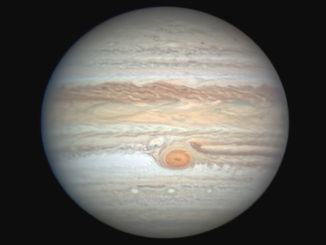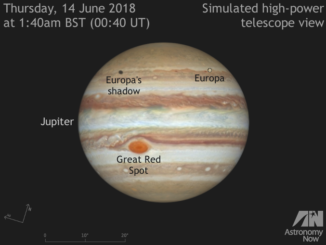
Great Red Spot


More Jupiter events to enjoy in August 2019
Jupiter is two months past opposition on 10 August, so you need to be looking low in the southern sky of the British Isles around sunset if you wish to catch the solar system’s largest planet at its best. If you time it right and the weather obliges, Jupiter’s Great Red Spot makes multiple appearances while the planet’s Galilean moons play hide and seek. Welcome to our August 2019 Jovian observing guide.

Further Jupiter events for UK observers in July 2019
July opens with Jupiter three weeks after opposition, but the largest planet is still putting on a fine show as an unmistakable magnitude -2.6 object low in the south before midnight in the constellation of Ophiuchus (the Serpent Bearer). With ongoing developments in the Jupiter’s Great Red Spot and plenty of phenomena occurring with the planet’s large Galilean moons, here’s our Jovian observing guide for July 2019.

Don’t miss Jupiter’s ‘unravelling’ Great Red Spot
The Great Red Spot (GRS) is the solar system’s largest known storm, an Earth-sized anticyclone that has raged in the atmosphere of Jupiter for at least two centuries. But recent observations from Earth and space suggest that this iconic Jovian feature is undergoing huge changes that could herald its demise.

Get ready for prime-time Jupiter and its multi-moon events in June 2019
Jupiter, the solar system’s largest planet, reaches opposition on 10 June in the constellation of Ophiuchus (the Serpent Bearer) and is visible low in the southern sky of the UK through the night. Observers with small to medium aperture telescopes can see a number of shadow transits of Jupiter’s Galilean moons and view the planet’s Great Red Spot throughout June.

See the Moon and Jupiter get close in the small hours of 21 May
Observers in the UK with clear skies around 1am BST on Tuesday, 21 May can see Jupiter, the solar system’s largest planet, just 4 degrees from the waning gibbous Moon low in the south-southeast. At this time both the Moon and Jupiter fit within the same field of view of binoculars magnifying less than 10×, while telescope users can also view Jupiter’s Great Red Spot.

See the Moon join a midnight planetary parade from 21–28 July
If clear skies persist, observers in the UK can view four naked-eye planets between now and the end of the month. Brightest planet Venus is visible low in the west some 45 minutes after sunset, while the waxing Moon is your celestial pointer to Jupiter, Saturn and Mars between 21 and 28 July at midnight.


June’s Jupiter events visible from the UK
Jupiter has passed opposition, but the solar system’s largest planet is still putting on a magnificent show in the southern sky at dusk. Backyard telescopes readily reveal its Great Red Spot storm feature and four main moons constantly playing tag. Here’s our full guide to Jovian events visible from the UK in June.

Jupiter’s 9 May opposition and a month of Jovian events visible from the UK
With the opposition of Jupiter occurring on 9 May, now is the time to ensure that your telescope is clean and collimated (aligned) to deliver the sharpest images of the solar system’s largest planet at its best. We tell you when and how to view Jupiter’s Great Red Spot and a wealth of Galilean moon phenomena throughout May 2018.
